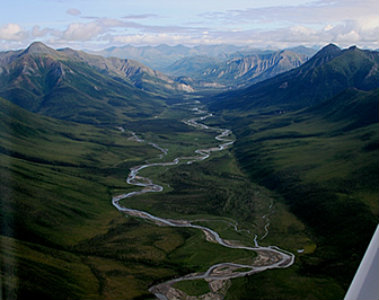
Courtesy of the National Park Service, Christy Spletcher
In the Brooks Range in northern Alaska, the northernmost mountain range in the United States, Gates of the Arctic National Park and Preserve (GAAR) covers nearly 8.5 million acres--a vast expanse of land that lies north of the Arctic Circle. The park and preserve contains tundra plains, mountain ridges and ranges, wild scenic rivers, forests, glacially formed lakes, arctic and subarctic climates, and well over 10,000 years of human history. This breathtaking landscape has served as the home to Native Alaskan peoples for many millennia.
Gates of the Arctic National Park and Preserve helps to protect the natural resources and also the cultural resources of Native Alaskan peoples. Today, 10 small communities with about 1,500 residents depend on these resources to maintain their subsistence lifestyle and their cultural traditions. Exploring the park and preserve’s richly diverse landscape, vegetation, fauna, and human history provides visitors a memorable experience of what it is like to live in this dramatic land.
As early as 11,500 years ago, peoples of the Paleoarctic tradition subsisted by hunting in small, mobile groups. Remnants of glacial ice would have dotted the valleys while these peoples moved throughout the land in harmonious rhythms with the seasons. Another group, the Paleo-Eskimos, appeared around 4,500 years ago. Paleo-Eskimos are the ancient ancestors of modern Eskimos, as determined by archeological studies throughout Alaska, Canada, and Greenland. More broadly, these people are part of the Arctic Small Tool Tradition, which includes the Denbigh, Choris, Norton, and Ipiutak traditions. These people, who made finely crafted and fully developed miniature tools, successfully exploited arctic coastal resources--including sea mammals and caribou, which enabled them to diffuse throughout North America and this region.
Recently, many Denbigh Paleo-Eskimos’ archeological remains were discovered at Matcharak Lake. Permafrost and the ongoing formation of peat at this site preserved the remains of numerous Denbigh Paleo-Eskimo meals. With this discovery, archeologists can better determine what the Denbigh Paleo-Eskimos ate and how they hunted and moved around the area seasonally. At the site, archeologists identified thousands of bones from animals such as caribou, fish, and migratory birds. They also found tools and incised-bone artwork. Future research at this site will help archeologists and researchers more thoroughly understand Native Alaskan behaviors and lifestyles.
During the last 1000 years, ancestral cultures of the Inupiat (Inupiaq) Eskimos and groups of Athabaskan Indian people appeared throughout this region. Artifacts found throughout the park and preserve such as the Eskimo hunting bow, obsidian tools, and the bones of animals including moose, sheep, and fish, reveal how the Inupiat Eskimos and the Athabaskan Indians used natural resources to survive in this harsh environment. The discovery of obsidian tools throughout the area reveals evidence of stone tool manufacturing and the trading and movement patterns of these prehistoric and historic peoples. Obsidian is a naturally occurring volcanic glass that can be extremely sharp. Obsidian can be traced to specific geographic locations through geological sourcing and is therefore an extremely valuable artifact that archeologists can use to understand Native Alaskan prehistoric and historic behaviors.
Thousands of artifacts were retrieved in 2004 at the Hungry Fox archeological site. These artifacts revealed that at one time, in what is today a seemingly remote and isolated landscape near a steep riverbank, a substantial Inupiaq settlement thrived throughout the 15th century. Artifacts retrieved from the site include fragile bird and fish bones, small game bones, caribou and sheep bones, split root cordage, wood shavings left from making tool handles, charcoal, fire cracked rock, stone tool debris, large stone slabs, flaked-stone arrow point, jade tools, bone and amber beads, and carved and incised pieces of bone and antler. The extensive quantity of archeological findings at this site reveals that through a system of hunting and gathering, a substantial Inupiaq settlement thrived in this remote area and acquired survival methods that would undoubtedly help future generations of Inupiat Eskimos.
By the 1880s, people of European descent, such as military explorers, gold prospectors, and government scientists found their way to the Brooks Range, almost two decades after the United States purchased Alaska. By the late 19th century, gold rushes in Alaska significantly altered the traditional lifestyles of the Native Alaskans. The Klondike and Nome gold rushes, which brought prospectors and others to the region that is now Gates of the Arctic National Park and Preserve, changed the lifestyles of the Eskimos and Athabascan peoples living in the area. Euro-Americans introduced new tools, materials, and labor systems. The Eskimos and Athabascans, who had survived through a semi-nomadic cycle of substance hunting and fishing for centuries, began to settle in villages and to become largely dependent upon the white man’s technologies, culture, and work opportunities.
While much has changed since the first settlers lived on this land thousands of years ago, many communities still utilize the subsistence hunting and fishing methods of their ancestors. Eleven designated “resident zone communities” in the vicinity of the park have special privileges regarding subsistence within park boundaries. The communities are Nuiqsut, Wiseman, Anaktuvuk Pass, Bettles, Evansville, Allakaket, Alatna, Hughes, Kobuk, Shungnak, and Ambler. By using methods of subsistence in this harsh environment, these modern Alaskan peoples carry on in the spirit of their ancestors.
Exploring Gates of the Arctic National Park and Preserve brings visitors into close contact with pristine nature and thousands of years of history giving them an appreciation of Native Alaskan cultural heritage and this dramatic landscape that necessitates such self and group reliance for survival.
Last updated: August 23, 2017
